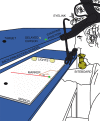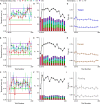Looking away from a moving target does not disrupt the way in which the movement toward the target is guided
- PMID: 32407436
- PMCID: PMC7409596
- DOI: 10.1167/jov.20.5.5
Looking away from a moving target does not disrupt the way in which the movement toward the target is guided
Abstract
People usually follow a moving object with their gaze if they intend to interact with it. What would happen if they did not? We recorded eye and finger movements while participants moved a cursor toward a moving target. An unpredictable delay in updating the position of the cursor on the basis of that of the invisible finger made it essential to use visual information to guide the finger's ongoing movement. Decreasing the contrast between the cursor and the background from trial to trial made it difficult to see the cursor without looking at it. In separate experiments, either participants were free to hit the target anywhere along its trajectory or they had to move along a specified path. In the two experiments, participants tracked the cursor rather than the target with their gaze on 13% and 32% of the trials, respectively. They hit fewer targets when the contrast was low or a path was imposed. Not looking at the target did not disrupt the visual guidance that was required to deal with the delays that we imposed. Our results suggest that peripheral vision can be used to guide one item to another, irrespective of which item one is looking at.
Figures










Similar articles
-
Continuous use of visual information about the position of the moving hand.Exp Brain Res. 2023 Aug;241(8):2001-2008. doi: 10.1007/s00221-023-06658-x. Epub 2023 Jun 29. Exp Brain Res. 2023. PMID: 37386195 Free PMC article.
-
Eye movements in interception with delayed visual feedback.Exp Brain Res. 2018 Jul;236(7):1837-1847. doi: 10.1007/s00221-018-5257-8. Epub 2018 Apr 19. Exp Brain Res. 2018. PMID: 29675715 Free PMC article.
-
Moving one's finger to a visually specified position: target orientation influences the finger's path.Exp Brain Res. 1995;105(2):318-20. doi: 10.1007/BF00240968. Exp Brain Res. 1995. PMID: 7498385
-
How the timing of visual feedback influences goal-directed arm movements: delays and presentation rates.Exp Brain Res. 2023 May;241(5):1447-1457. doi: 10.1007/s00221-023-06617-6. Epub 2023 Apr 17. Exp Brain Res. 2023. PMID: 37067561 Free PMC article.
-
Why do the eyes prefer the index finger? Simultaneous recording of eye and hand movements during precision grasping.J Vis. 2013 Apr 18;13(5):15. doi: 10.1167/13.5.15. J Vis. 2013. PMID: 23599419
Cited by
-
Motion-in-depth effects on interceptive timing errors in an immersive environment.Sci Rep. 2021 Nov 9;11(1):21961. doi: 10.1038/s41598-021-01397-x. Sci Rep. 2021. PMID: 34754000 Free PMC article.
-
Continuous use of visual information about the position of the moving hand.Exp Brain Res. 2023 Aug;241(8):2001-2008. doi: 10.1007/s00221-023-06658-x. Epub 2023 Jun 29. Exp Brain Res. 2023. PMID: 37386195 Free PMC article.
-
Micropursuit and the control of attention and eye movements in dynamic environments.J Vis. 2021 Aug 2;21(8):6. doi: 10.1167/jov.21.8.6. J Vis. 2021. PMID: 34347019 Free PMC article.
-
The effect of impaired velocity signals on goal-directed eye and hand movements.Sci Rep. 2023 Aug 22;13(1):13646. doi: 10.1038/s41598-023-40394-0. Sci Rep. 2023. PMID: 37607970 Free PMC article.
References
-
- Berkinblit M. B., Fookson O. I., Smetanin B., Adamovich S. V., & Poizner H. (1995). The interaction of visual and proprioceptive inputs in pointing to actual and remembered targets. Experimental Brain Research, 107(2), 326–330 - PubMed
-
- Braun D. I., Mennie N., Rasche C., Schütz A. C., Hawken M. J., & Gegenfurtner K. R. (2008). Smooth pursuit eye movements to isoluminant targets. Journal of Neurophysiology, 100(3), 1287–1300. - PubMed
-
- Brenner E., & Smeets J. B. J. (1997). Fast responses of the human hand to changes in target position. Journal Motor Behavior, 29(4), 297–310. - PubMed
-
- Brenner E., & Smeets J. B. J. (2003). Fast corrections of movements with a computer mouse. Spatial Vision, 16(3), 365–376. - PubMed

